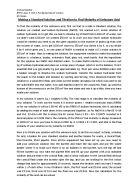Making a Standard Solution and Titration to Find Molarity of Unknown Acid
Joshua Dawber
BTEC Level 3: Unit 1 Fundamentals of science
Mr Nolan
Making a Standard Solution and Titration to Find Molarity of Unknown Acid
To find the molarity of the unknown acid, first we had to create a standard solution, the solution we created was Sodium Hydroxide (NaOH). We wanted a 0.1 molar solution of sodium hydroxide so to get this we had to dissolve 4g of NaOH into 1000cm³ of water, but we didn’t want 1000cm³ we wanted 250cm³ so to work out how much sodium hydroxide would be needed you need to do the same equation to the number of grams (g) than with the volume of water, so to get 1000cm³ down to 250cm³ you divide it by 4, so you divide 4 by 4 which gives you 1, so one gram of NaOH is needed to make a 0.1 molar solution in 250cm³ of water. Next is making the solution, the equipment needed to make this standard solution is: a balance, beaker, volumetric flask, glass rod, wash bottle. And the ingredients for the solution are NaOH and distilled water. To make NaOH solution is to measure out 1g of sodium hydroxide and place on a scrap piece of paper which is on the balance, it isn’t essential that you get exactly 1g just approximately 1g. Then put some distilled water into a beaker enough to dissolve the sodium hydroxide, transfer the sodium hydroxide from the paper to the beaker and dissolve by swirling and stirring. Once dissolved transfer this solution to a volumetric flask, and wash out the beaker and glass rod which was used to stir the solid NaOH into the water, now add distilled water to the volumetric flask, up until the bottom of the meniscus is on the 250cm³ line and shake and mix it up a little, then you have made your solution.








